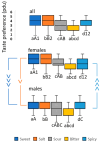A Survey on the Evaluation of Monosodium Glutamate (MSG) Taste in Austria
- PMID: 39796312
- PMCID: PMC11719957
- DOI: 10.3390/foods14010022
A Survey on the Evaluation of Monosodium Glutamate (MSG) Taste in Austria
Abstract
The umami taste is well validated in Asian culture but remains less recognized and accepted in European cultures despite its presence in natural local products. This study explored the sensory and emotional perceptions of umami in 233 Austrian participants who had lived in Austria for most of their lives. Using blind tasting, participants evaluated monosodium glutamate (MSG) dissolved in water, providing open-ended verbal descriptions, pleasantness ratings, and comparisons to a sodium chloride (NaCl) solution. Discrimination tests excluded MSG ageusia, and basic demographic data were collected. A text semantic-based analysis (TSA) was employed to analyze the emotional valence and descriptive content of participants' responses. The results showed that MSG was predominantly associated with neutral sentiments across the group, including both female and male subgroups. "Sour" was the most frequent taste descriptor, while "unfamiliar" characterized the perceptual experience. Pleasantness ratings for MSG and NaCl were positively correlated, suggesting that overcoming the unfamiliarity of umami could enhance its acceptance and align it with the pleasantness of salt. These findings advance the understanding of umami sensory perception and its emotional and cultural acceptance in European contexts, offering valuable insights for integrating umami into Western dietary and sensory frameworks.
Keywords: cultural acceptance; perception; sensory analysis; text sentiment analysis.
Conflict of interest statement
The authors declare no conflict of interest.
Figures








Similar articles
-
Effect of Addition of Umami and Sour Components on NaCl Taste in Humans.J Nutr Sci Vitaminol (Tokyo). 2023;69(4):292-298. doi: 10.3177/jnsv.69.292. J Nutr Sci Vitaminol (Tokyo). 2023. PMID: 37648516
-
Investigation of Monosodium Glutamate Alternatives for Content of Umami Substances and Their Enhancement Effects in Chicken Soup Compared to Monosodium Glutamate.J Food Sci. 2019 Nov;84(11):3275-3283. doi: 10.1111/1750-3841.14834. Epub 2019 Oct 11. J Food Sci. 2019. PMID: 31602667
-
Effect of Monosodium Glutamate on Saltiness and Palatability Ratings of Low-Salt Solutions in Japanese Adults According to Their Early Salt Exposure or Salty Taste Preference.Nutrients. 2021 Feb 9;13(2):577. doi: 10.3390/nu13020577. Nutrients. 2021. PMID: 33572364 Free PMC article.
-
Monosodium glutamate as a tool to reduce sodium in foodstuffs: Technological and safety aspects.Food Sci Nutr. 2017 Jul 13;5(6):1039-1048. doi: 10.1002/fsn3.499. eCollection 2017 Nov. Food Sci Nutr. 2017. PMID: 29188030 Free PMC article. Review.
-
Sensory and receptor responses to umami: an overview of pioneering work.Am J Clin Nutr. 2009 Sep;90(3):723S-727S. doi: 10.3945/ajcn.2009.27462E. Epub 2009 Jul 1. Am J Clin Nutr. 2009. PMID: 19571221 Review.
Cited by
-
Survey data of perception and evaluation of umami taste in Austria.Data Brief. 2025 May 31;61:111734. doi: 10.1016/j.dib.2025.111734. eCollection 2025 Aug. Data Brief. 2025. PMID: 40534918 Free PMC article.
References
-
- Ikeda K. On a new seasoning. J. Tokyo Chem. Soc. 1909;30:820–836. doi: 10.1093/chemse/27.9.847. - DOI
-
- Steiner J.E. In: What the Infant Can Tell Us About Umami in Umami: A Basic Taste. Kawamura Y., Kare M.R., editors. Marcel Dekker; New York, NY, USA: 1987. pp. 97–123.
Grants and funding
LinkOut - more resources
Full Text Sources
Research Materials

